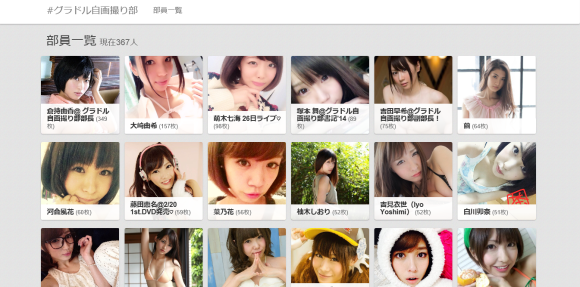
So today, we’d like to talk about a website called Jigadoribu. We won’t beat around the bush, it’s a site full of pictures of swimsuit models. And to all those of you who haven’t immediately skipped to the photos after reading that last sentence, thank you. Your display of self-restraint is an inspiration to us all, especially if you’re in the office, as this isn’t the sort of thing you want to be reading at work.
Sadly, our bosses won’t pay us for features that consist entirely of the phrase “And check this girl out!” repeated a dozen times. Likewise, we imagine you’d have some explaining to do should someone peek over your shoulder and see you perusing this article. So, as we did before, we’re going to mix appreciation of the female form with a little Japanese language lesson.
Let’s start with vocabulary word number one: jigadori, or selfie.
Okay, did everyone memorize that? Great. Here’s your reward.
So let’s examine the etymology of the word jigadori, and learn the kanji characters for it as we go along. First, we’ve got ji / 自, which means “self.” We’re going to combine that with the kanji 画, which means “picture” and is read as kaku when it’s by itself. Put it in a compound with another kanji, though, and the pronunciation changes to ga, so our combination of 自画 becomes jiga, or a picture of oneself.
▼ For example, this is a jiga
With us so far? Good. Wait, where are your eyes going? Back down here, please!
Unfortunately, the limited syllabary of the Japanese language means there are only so many possible sounds to work with. A short word like jiga could easily be mistaken for one of its several possible homonyms, such as 自我, the psychological ego. This, of course, presents potential communication problems.
▼ Many guys take psychology classes as a way to meet girls, but the field is a much slower-acting antidote than bikini models for the sleepless nights when they fail to obtain said female companionship.
So in order to ensure that your request for pictures of scantily clad women isn’t mistakenly answered with a book on the theories of Sigmund Freud, you need to add a little more detail to plain old jiga. The Japanese word for “take,” as in “take a picture,” is toru. Like all Japanese verbs, it ends in the letter U, but as is often the case, we can change it into a noun by swapping that terminal U for an I and making it tori.
▼ Phew, that was a lot of grammar. Let’s take a second and recharge.
But as much as we’d like to just slap jiga and tori together, we’re not quite ready to do the deed yet. The ga-ta combination sounds needlessly harsh to Japanese ears and is kind of tough to pronounce, so that hard T gets softened into a D, giving us our final product, jigadori, a self-taken image, or selfie. Add in a final bu / 部, meaning department or team, and you’ve got the website’s name, Jigadoribu, or The Selfie Department.
Ready for more fun with linguistics? We fudged the details a bit when we said Jigdoribu is filled with shots of swimsuit models. Technically they’re guradoru, a term used to denote female models in a number of skimpy outfits. Unlike jigadori, guradoru doesn’t have any kanji characters. Instead, it’s written in the phonetic script called katakana, because it consists of two English loanwords pressed together.
▼ Did we just go two paragraphs without giving you a break? We’re sorry. Here, have a double dose of guradoru.
So, the word gravure means a cut or engraving, and is connected to the term photogravure, an early method of printing photographs. Somewhere along the line, the word got appropriated in Japanese to mean “fashion models who show a lot of skin.” No, we’re not sure how this happened either, but bear in mind Japanese is the same language in which hair bands are called kachusha because of a character in a Tolstoy novel.
Once again, though, the Japanese syllabary means that gravure gets corrupted to gurabia, and cutting this in half gives us the first portion of guradoru.
▼ Let’s double up our vocabulary usage: This is a gurabia jigadori.
Some of the most popular gurabia go on to build sizeable fan bases, not unlike the idols of the Japanese music industry. If you’ll forgive us for trotting out the Japanese syllabary explanation one final time, though, the pronunciation of idol in Japanese is aidoru. Take the last two syllables of that, stick it on the truncated form of gurabia we talked about above, and now you’ve got guradoru, a gravure idol.
Even though there’s a whole industry of professional cameraman waiting for the call to take pictures of guradoru (as well as, we’re sure, legions of willing amateur volunteers), the models aren’t immune to the power of the online-shared selfie. This is the point in our story where Jigadoribu comes in, as the site’s mission is to collect and catalogue these privately taken snapshots of exhibitionism.
Coincidentally, this is also the point in our story where we’ve run out of Japanese grammar and vocab to help justify all the time you’re spending on this page. Feel free to stick around as long as you’d like though. Next period is math class, by the way.
▼ The volume of a sphere is equal to four-thirds times pi times the radius cubed.
Source: Jigadoribu
Top image: Jigadoribu
Insert images: Jigadoribu, Blogspot